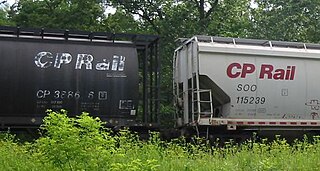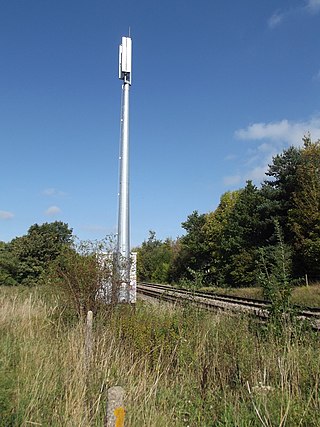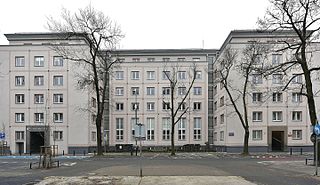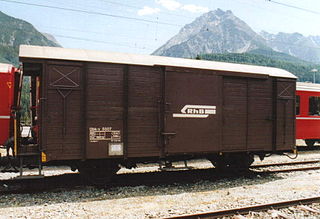
Intermodal freight transport involves the transportation of freight in an intermodal container or vehicle, using multiple modes of transportation, without any handling of the freight itself when changing modes. The method reduces cargo handling, and so improves security, reduces damage and loss, and allows freight to be transported faster. Reduced costs over road trucking is the key benefit for inter-continental use. This may be offset by reduced timings for road transport over shorter distances.

A loading gauge is a diagram or physical structure that defines the maximum height and width dimensions in railway vehicles and their loads. Their purpose is to ensure that rail vehicles can pass safely through tunnels and under bridges, and keep clear of platforms, trackside buildings and structures. Classification systems vary between different countries, and gauges may vary across a network, even if the track gauge is uniform.

A reporting mark is a code used to identify owners or lessees of rolling stock and other equipment used on certain rail transport networks. The code typically reflects the name or identifying number of the owner, lessee, or operator of the equipment.

GSM-R, Global System for Mobile Communications – Railway or GSM-Railway is an international wireless communications standard for railway communication and applications.

The European Train Control System (ETCS) is a train protection system designed to replace the many incompatible systems used by European railways, and railways outside of Europe. ETCS is the signalling and control component of the European Rail Traffic Management System (ERTMS).

Rail freight transport is the use of railways and trains to transport cargo as opposed to human passengers.
The African Union of Railways is an organisation under the auspices of the new African Union dealing with railways. It is similar to the International Union of Railways (UIC).
The European Rail Traffic Management System (ERTMS) is the system of standards for management and interoperation of signalling for railways by the European Union (EU). It is conducted by the European Union Agency for Railways (ERA) and is the organisational umbrella for the separately managed parts of
European Rail Infrastructure Managers (EIM) is a sector association that represents the interests of European rail infrastructure managers. Members consist of owners/managers of infrastructure from most European/EEA countries.

Goods wagons or freight wagons, also known as goods carriages, goods trucks, freight carriages or freight trucks, are unpowered railway vehicles that are used for the transportation of cargo. A variety of wagon types are in use to handle different types of goods, but all goods wagons in a regional network typically have standardized couplers and other fittings, such as hoses for air brakes, allowing different wagon types to be assembled into trains. For tracking and identification purposes, goods wagons are generally assigned a unique identifier, typically a UIC wagon number, or in North America, a company reporting mark plus a company specific serial number.

The Organization for Cooperation of Railways, was established as the equivalent of the International Union of Railways (UIC) to create and improve the coordination of international rail transport. Concerning especially the transports between Europe and Asia, it has helped develop cooperation between railway companies and with other international organisations. The members of this organisation created an international transport law.

Flat wagons, as classified by the International Union of Railways (UIC), are railway goods wagons that have a flat, usually full-length, deck and little or no superstructure. By contrast, open wagons have high side and end walls and covered goods wagons have a fixed roof and sides. Flat wagons are often designed for the transportation of goods that are not weather-sensitive. Some flat wagons are able to be covered completely by tarpaulins or hoods and are therefore suitable for the transport of weather-sensitive goods. Unlike a "goods wagon with opening roof", the loading area of a flat is entirely open and accessible once the cover is removed.

This list contains the UIC classification of goods wagons and their meanings. The description is made up of a category letter and usually several index letters.
The UIC identification marking for tractive stock is a standard for identifying train stock like locomotives that supply tractive force primarily in Europe. Since the beginning of 2007 locomotives or other traction units in Europe have been given a 12-digit number. Vehicle numbering is now governed by the Intergovernmental Organisation for International Carriage by Rail and in Technical Specifications for Interoperability (TSI) of the European Union, specifically the European Railway Agency's CR OPE TSI. This makes the locomotive clearly identifiable within Europe and parts of Asia and northern Africa.

Wagon numbers are key data for railway operations. They enable a railway wagon or coach to be positively identified and form a common language between railway operators, infrastructure companies and the state authorities. The system of wagon numbering has been laid down by the International Union of Railways and is similar to that used for the locomotives and multiple units. Vehicle numbering is now governed by the Intergovernmental Organisation for International Carriage by Rail and in Technical Specifications for Interoperability (TSI) of the European Union.

A covered goods wagon or van is a railway goods wagon which is designed for the transportation of moisture-susceptible goods and therefore fully enclosed by sides and a fixed roof. They are often referred to simply as covered wagons, and this is the term used by the International Union of Railways (UIC). Since the introduction of the international classification for goods wagons by the UIC in the 1960s a distinction has been drawn between ordinary and special covered wagons. Other types of wagon, such as refrigerated vans and goods wagons with opening roofs, are closely related to covered wagons from a design point of view. Similar freight cars in North America are called boxcars.
Rail Cargo Austria (RCA) is an Austrian rail freight transportation company with its headquarters in Vienna. It was founded on 1 January 2005 as an independent company from the freight transport division of the ÖBB Group.

The National Railway Infrastructure Company is Bulgaria's state railway infrastructure company, established as an entity on 1 January 2002. The company's headquarters are located in the capital city Sofia near Sofia Central Station. It is the owner and operator of most of the country's rail lines.

The European Union Agency for Railways (ERA) is an agency of the European Union (EU) that sets mandatory requirements for European railways and manufacturers in the form of Technical Specifications for Interoperability (TSI), which apply to the Trans-European Rail system. The ERA publishes a document summarising the status of the TSIs. The ERA sets common safety targets, common safety methods and common safety indicators, following Directive 2004/49/EC and amendments. The ERA also hosts a number of databases, among which a register of remaining, applicable national rules.















